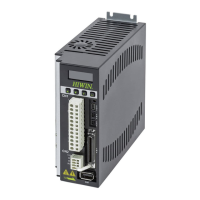
Do you have a question about the Hiwin D2 and is the answer not in the manual?
Guidelines and warnings for safe and correct operation of the D2-series drives.
Categorized safety instructions covering warnings, attention, prohibitions, and requirements for safe operation.
Details on safety certifications, nameplate information, and model number structure.
Comprehensive technical specifications of the D2 drive, covering input, output, and environment.
Illustrations and dimensions of various D2 drive models, including mounting hole details.
Instructions for proper installation of the drive, including grounding, spacing, and environmental considerations.
System requirements for the PC used with the drive's software, including CPU, RAM, and OS.
Description of available operation modes: Position, Velocity, Force/Torque, and Stand-alone.
Explanation of supported encoder types: Digital and Analog, noting D2 drives support digital only.
Details on buffered and emulated encoder output modes for sending signals to host controllers.
Concepts of path planning including position, velocity, acceleration, and smooth factor.
Explanation of servo control loops and the use of a common gain for simplified tuning.
Analysis of gain margin and phase margin using Nyquist and Bode diagrams.
Defines move time, settling time, and the 'In-position' signal.
Method for improving positioning accuracy using an error map and linear interpolation.
Explanation of velocity ripple as a measure of motion stability and its calculation.
Description of the enable step required before receiving motion commands, including Step motion mode.
Table listing and describing common physical quantities used in the drive system.
Overview of system configuration and function of each drive connector.
Details on CN1 power wiring for frame A-C and frame D models, including regenerative resistor and DC reactor.
Wiring for CN2 connector as brake connector (A-C) or motor power connector (D).
Instructions for connecting the drive to a PC via USB for monitoring and parameter setting.
Configuration for Modbus communication using RS485 with host controllers.
Details on CN5 connectors for Modbus or safety function input.
Pin assignment and voltage requirements for CN6 control signal.
Pin assignment and signal definitions for the CN7 encoder connector.
Connection details for EtherCAT module using CN8 connector.
Specifications and pin assignments for the extension I/O module connectors.
Information on available accessories like motor power cables, encoder cables, and control signal cables.
Guidelines for AC power wiring, including single-phase and three-phase connections.
Instructions for connecting multiple drives in parallel, with cautions regarding power connections.
Wiring examples for digital input and output signals.
Illustrations of wiring for pulse, voltage, and PWM control commands.
Steps for installing the Lightening HMI software and establishing communication with the drive.
Guide to configuring motor, encoder, and operation modes within the software.
Procedure for auto phase initialization using STABS or LSWIR methods.
Process for automatic gain tuning to optimize servo response and system stability.
Configuration of digital inputs and outputs, including status indicators and logic inversion.
Setting target radius and debounce time for the 'In-position' signal.
Parameters and modes for configuring the homing procedure.
Instructions for saving parameters to Flash and restoring factory default settings.
Practical examples of setting parameters for Position, Velocity, Force/Torque, and Stand-alone modes.
Tools for monitoring drive status, including status indicators and quick view of physical quantities.
Interface for motion testing and tuning, supporting P2P, relative, and continuous motion.
Using the oscilloscope tool to observe physical quantities and analyze tuning results.
Features for capturing and processing drive data, including manual and conditional auto collection.
Analysis tool for visualizing and calculating collected data with zoom and mathematical functions.
Configuration of advanced parameters like filters, feed-forward, schedule gains, and VSF.
Tool for analyzing control system stability via Nyquist, Bode, and Nichols diagrams.
Procedures to verify the encoder signal and value using HMI functions.
Setting up and enabling the error map for improving positioning accuracy.
Setting up backlash compensation to improve bi-directional reproducibility.
Overview of LCD panel functions, including panel description and operation page structure.
Step-by-step guide for initializing parameters using the drive's LCD panel.
Display of servo status, errors, and warnings on the LCD's home page.
Navigating and viewing various drive parameters and their status via the LCD.
Procedure for modifying common and advanced parameters via the LCD.
Performing motor functions like enable/disable, jog, absolute motion, and auto tune via LCD.
Examples demonstrating parameter settings for Position, Velocity, Force/Torque, and Stand-alone modes via LCD.
Limiting speed, acceleration, deceleration, and emergency stop for motor output.
Setting limits and warnings for position and velocity errors to prevent anomalies.
Configuration of brake signal output for actuating external electromagnetic brakes.
Implementing hardware and software limits to protect against over-stroke conditions.
Functions for estimating motor temperature and protecting the drive from overheating.
Details on over-voltage protection and the use of regenerative resistors.
Methods for enabling the motor via host controller or temporary hardware enable.
Verifying the motor enable status through the HMI and using F12 for emergency stop.
Observing differences between RAM and Flash parameters and managing them.
Procedure for updating the drive's firmware using the Lightening software.
Steps for loading a PDL program into the drive via the PDL edit interface.
Details on Modbus communication parameters like baud rate, parity, and data length.
Description of Modbus function codes for reading and writing registers, including error codes.
Listing of Modbus objects with data types, ranges, and register addresses.
Guidelines for using common-mode motor filters to reduce noise and improve motor control.
Recommendations for using magnetic rings on motor power cables to mitigate noise interference.